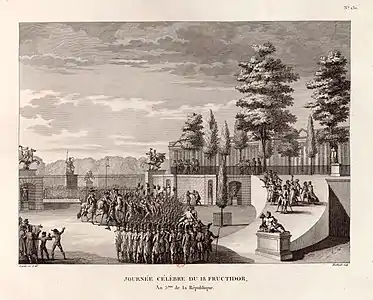Coup of 18 Fructidor
The Coup of 18 Fructidor, Year V, was a seizure of power by members of the French Directory on 4 September 1797 while their opponents, the Royalists, were gaining strength. Howard G. Brown, Professor of History at Binghamton University, stresses the turn toward dictatorship and the failure of liberal democracy under the Directory, blaming it on "chronic violence, ambivalent forms of justice, and repeated recourse to heavy-handed repression."[1]
| Coup of 18 Fructidor | |||||||
|---|---|---|---|---|---|---|---|
| Part of the French Revolution | |||||||
 Acting for the coup's leaders, General Pierre Augereau stormed the Tuileries Palace to arrest Charles Pichegru and others accused of plotting a counter-revolution. | |||||||
| |||||||
| Belligerents | |||||||
| French Directory: |
Council of Ancients Council of Five Hundred | ||||||
| Commanders and leaders | |||||||
| |||||||
| Strength | |||||||
| 80,000 | 216 royalist deputies | ||||||
| Casualties and losses | |||||||
| |||||||
History
Three Directors, Paul Barras, Jean-François Rewbell and Louis Marie de La Révellière-Lépeaux and foreign minister Charles Maurice de Talleyrand-Périgord,[2] staged the coup d'état with support from the military.[3] Royalist candidates had gained 87 seats in the most the recent elections, where a third of the seats were at stake. They were poised to later win the next round of elections and assume control of the Directory.
Jean-Charles Pichegru, a figure widely assumed to be acting in sympathy to the monarchy and its restoration, was elected President of the Council of Five Hundred.[3] After documentation of Pichegru's treasonous activities was supplied by Napoleon Bonaparte, the Directors accused the entire body of plotting against the Revolution and moved quickly to annul the elections and arrest the royalists.[3]
At dawn 4 September 1797, Paris was declared to be under martial law, while a decree was issued, asserting that anyone supporting royalism or the restoration of the Constitution of 1793 was to be shot without trial. To support the coup, General Lazare Hoche, then commander of the Army of Sambre-et-Meuse, arrived in the capital with his troops, while Bonaparte sent troops under Pierre Augereau. Pichegru, Dominique-Vincent Ramel-Nogaret, François-Marie, marquis de Barthélemy and Amédée Willot were arrested, while Lazare Carnot made good his escape. 214 deputies were arrested and 65 were subsequently exiled to Cayenne in French Guiana including Pichegru, Ramel, Barthélemy and Carnot. The election results in 49 departments were annulled. The two newly vacant places in the Directory were filled by Philippe Merlin de Douai and Nicolas-Louis François de Neufchâteau.[2]
The 80-gun ship of the line Foudroyant was briefly named Dix-huit fructidor in honour of the event.
Notes
- Brown (2007). Ending the French Revolution: Violence, Justice, and Repression from the Terror to Napoleon. p. 1.
- Bernard, pp. 193–194.
- Doyle, William (2002). The Oxford History of the French Revolution. Oxford: Oxford University Press. p. 330. ISBN 978-0-19-925298-5.
References
- Bernard, J.F. (1973). Talleyrand: A Biography. New York: Putnam. ISBN 0-399-11022-4.
- (in French) Site sur A-D Laffon de Ladebat
- (in French) Site sur le coup d'état du 18 fructidor
- (in French) "Les pionniers de la guillotine sèche en Guyane française sous le Directoire" Philippe de Ladebat, éd. Amalthée Nantes, 2008